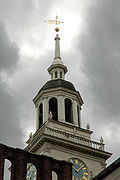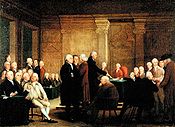- Congress of the Confederation
-
Congress of the Confederation The Articles of Confederation Type Type Unicameral Timeline United States Established 1781 Preceded by Second Continental Congress Succeeded by 1st United States Congress Disbanded 1789 Members Variable; ~50 Meeting place Variable Footnotes Though there were about 50 members of the Congress at a given time, it was the states that had votes, so there were effectively only 13 seats. The Congress of the Confederation or the United States in Congress Assembled was the governing body of the United States of America that existed from March 1, 1781, to March 4, 1789. It comprised delegates appointed by the legislatures of the states. It was the immediate successor to the Second Continental Congress. It referred to itself as the Continental Congress throughout its eight year history.[1] The membership of the Second Continental Congress automatically carried over to the Congress of the Confederation when the latter was created by the ratification of the Articles of Confederation. The Congress of the Confederation was succeeded by the United States Congress.[2]
Contents
Events
The Congress of the Confederation opened in the last stages of the American Revolution. Combat ended in October 1781 with the surrender of the British at the Battle of Yorktown. The British, however, continued to occupy New York City, while the American delegates in Paris, named by the Congress, negotiated the terms of peace with Great Britain.[3] Based on preliminary articles made on November 30, 1782, and approved by the Congress of the Confederation on April 15, 1783, the Treaty of Paris was signed on September 3, 1783, and ratified by Congress on January 14, 1784, formally ending the American Revolutionary War between the Kingdom of Great Britain and the thirteen former colonies which on July 4, 1776, had declared independence.
The Congress had little power and without the external threat of a war against the British, it became more difficult to get enough delegates to meet to form a quorum. Nonetheless the Congress still managed to pass important laws, most notably the Northwest Ordinance.
The War of Independence saddled the country with an enormous debt. In 1784, the total federal debt was nearly $40 million. Of that sum, $8 million was owed to the French and Dutch. Of the domestic debt, government bonds, known as loan-office certificates, composed $11.5 million, certificates on interest indebtedness $3.1 million, and continental certificates $16.7 million.
The certificates were non-interest bearing notes issued for supplies purchased or impressed, and to pay soldiers and officers. To pay the interest and principal of the debt, Congress had twice proposed an amendment to the Articles granting them the power to lay a 5% duty on imports, but amendments required the consent of all thirteen states. Rhode Island and Virginia rejected the 1781 impost plan while New York rejected the 1783 revised plan.
Without revenue, except for meager voluntary state requisitions, Congress could not even pay the interest on its outstanding debt. Meanwhile, the states regularly failed, or refused, to meet the requisitions requested of them by Congress.[4]
To that end, in September 1786, the Annapolis Convention first attempted to look into improving the Articles of Confederation. There were enough problems that the Congress called a convention in 1787 to recommend changes. The Philadelphia Convention instead issued a Constitution to replace the Articles. The Congress submitted the Constitution to the states, and the Constitution was ratified by enough states to become operative in September 1788. On September 12, 1788, the Congress set the date for choosing the electors for President as January 7, 1789, the date for the electors to vote for President as February 4, 1789, and the date for the Constitution to become operative as March 4, 1789.
The Congress of the Confederation continued to conduct business for another month after setting the various dates. On October 10, 1788, the Congress formed a quorum for the last time; afterwards, although delegates would occasionally appear, there were never enough to conduct business, and so the Congress of Confederation passed into history. The last "meeting" of the Continental Congress was held March 2, 1789, two days before the Constitutional government took over; only one member was present at said meeting, Philip Pell, an ardent Anti-Federalist and opponent of the Constitution, who was accompanied by the Congressional secretary. Pell oversaw the meeting and adjourned the Congress sine die.
Meeting sites
Continental Congress First Continental Congress Second Continental Congress Confederation Congress Members From 1776 to 1800, Congress met in numerous locations. Therefore, the following cities can be said to have once been the United States capital.[5] The Congress of the Confederation initially met at the Pennsylvania State House (Independence Hall), in Philadelphia, Pennsylvania (March 1, 1781 to June 21, 1783). It then met at Nassau Hall, in Princeton, New Jersey (June 30, 1783 to November 4, 1783), at the Maryland State House, in Annapolis, Maryland (November 26, 1783 to August 19, 1784), at the French Arms Tavern, in Trenton, New Jersey (November 1, 1784 to December 24, 1784), and City Hall (Federal Hall), in New York City, New York (January 11, 1785 to Autumn 1788). After the ratification of the United States Constitution, the new Congress of the United States met in Federal Hall, New York City (March 4, 1789 to December 5, 1790) and Congress Hall, Philadelphia (December 6, 1790 to May 14, 1800), before making its permanent home in the United States Capitol, Washington, D.C., on November 17, 1800.
Sessions
- First Confederation Congress
-
- March 1, 1781 – November 3, 1781, Philadelphia, Pennsylvania
- Second Confederation Congress
-
- November 5, 1781 – November 2, 1782, Philadelphia
- Third Confederation Congress
See also: Pennsylvania Mutiny of 1783-
- November 4, 1782 – June 21, 1783, Philadelphia
- June 30, 1783 – November 1, 1783, Princeton, New Jersey
- Fourth Confederation Congress
-
- November 3, 1783 – November 4, 1783, Princeton
- Fifth Confederation Congress
-
- November 26, 1783 – June 3, 1784, Annapolis, Maryland
- Sixth Confederation Congress
-
- November 1, 1784 – December 24, 1784, Trenton, New Jersey
- January 11, 1785 – November 4, 1785, New York, New York
- Seventh Confederation Congress
-
- November 7, 1785 – November 3, 1786, New York
- Eighth Confederation Congress
-
- November 6, 1786 – October 30, 1787, New York
- Ninth Confederation Congress
-
- November 5, 1787 – October 21, 1788, New York
- Tenth Confederation Congress
-
- November 3, 1788 – March 2, 1789, New York
See also
- History of the United States (1776–1789)
- List of Continental Congress Delegates
- President of the Continental Congress
- Committee of the States
Footnotes
- ^ Journals of the Continental Congress, 1774-1789. Edited by Worthington C. Ford et al. 34 vols. Washington, D.C.: Government Printing Office, 1904-37.
- ^ "Confederation Congress". Ohio Historical Society. http://ohiohistorycentral.org/entry.php?rec=2327. Retrieved October 23, 2010.
- ^ See: Peace of Paris (1783)#Treaty with the United States of America.
- ^ Proposed Amendments to the Articles of Confederation Journals of the Continental Congress, 1774--1789. Edited by Worthington C. Ford et al. 34 vols. Washington, D.C.: Government Printing Office, 1904--37. 31:494-98
- ^ The Nine Capitals of the United States. United States Senate Historical Office. Accessed June 9, 2005. Based on Fortenbaugh, Robert, The Nine Capitals of the United States, York, PA: Maple Press, 1948. See: List of capitals in the United States#Former national capitals.
Bibliography
- Burnett, Edmund C.. The Continental Congress. Greenwood Publishing. ISBN 0837183863.
- Henderson, H. James. Party Politics in the Continental Congress. Boston: Rowman & Littlefield. ISBN 0819165255.
- Jensen, Merrill (1950). New Nation: A History of the United States During the Confederation, 1781–1789. New York: Knopf.
- McLaughlin, Andrew C. (1935). A Constitutional History of the United States. ISBN 9781931313315.
- Montross, Lynn. The Reluctant Rebels; the Story of the Continental Congress, 1774–1789. New York: Barnes & Noble. ISBN 038903973X.
- Morris, Richard B. (1987). The Forging of the Union, 1781–1789. New York: Harper & Row. ISBN 0060914246.
- Morris, Richard B. (1956). "The Confederation Period and the American Historian". William and Mary Quarterly 13 (2): 139–156. doi:10.2307/1920529. JSTOR 1920529.
- Rakove, Jack N. (1979). The Beginnings of National Politics: An Interpretive History of the Continental Congress. New York: Knopf. ISBN 0394423704.
External links
- Major documents from the Congress, including journals, letters, debates, via Library of Congress
- The Continental Congress - History, Declaration and Resolves, Resolutions and Recommendations, via AmericanRevolution.com
Preceded by
Second Continental CongressNational Legislature of the United States
March 1, 1781 – March 4, 1789Succeeded by
United States CongressPennsylvania during the American Revolutionary War1774 
1775 1776 1777 1778 1781 - Congress of the Confederation
- Mutiny of the Pennsylvania Line
1783 Location of the capital of the United States and predecessors Colonies 1774 First Continental Congress 1775 – 1781 Second Continental Congress 1781 – 1789 Congress of the Confederation 1789 – present Federal government of the United States First Continental Congress • Second Continental Congress • The US in Congress Assembled • Delegates • Committee of the StatesCongressional Officers civil officers Postmaster General • Superintendent of Finance/Agent of the Marine • Secretary at War • Secretary of Foreign Affairsmilitary Categories:- Continental Congress
- History of the United States government
- History of Philadelphia, Pennsylvania
- Pennsylvania in the American Revolution
- 1781 establishments in the United States
- 1789 disestablishments
- Defunct unicameral legislatures
Wikimedia Foundation. 2010.


